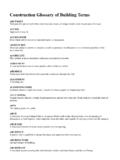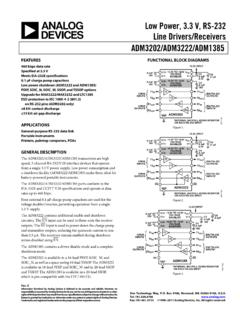Transcription of Slab Edge Dampness - Residential Reports
1 GENERALThe majority of houses incorporating well-constructed and well-detailed concrete slabs andfootings experience no problems with slab edgedampness. Where problems do occur, there may beone or more of several causes. A thoroughinvestigation is required to determine the mostappropriate course of action to rectify the slab edges are occasionally damp due torain, garden watering or by contact with the some cases this Dampness is able to permeatefrom the outside to the inside and affect the internalwalls and/or finishes such as the floor coverings. Preventative measures are far more effectivethan facing the often difficult and costly repairsrequired to remedy problems caused by slab edgedampness and moisture data sheet explains why slab edgedampness occurs and provides recommendations toreduce the risk of moisture ingress and thus avoidthe associated OF SLAB EDGE DAMPNESSThe initial indication of a problem is usuallypersistent Dampness of the exposed face of theconcrete slab/footing, often resulting in associatedefflorescence (a build up of a white colouredpowdery substance) below the damp-proof course(DPC).
2 It may also result in the development of:npungent odours in floor coverings ie damp carpets;nwatermark stains on wall linings and/or joinery;nmould growth;nrusting, surface corrosion or oxidisation of metalnear or adjacent to the edge of the slab/footing;nloss of bond of adjacent wall and floor tiles;nexternal paint blistering/peeling below the DPC;ndelaminating (drummy) render below the A N2005 DATA sheet>>SLAB EDGE Dampness andMoisture IngressTHE INITIAL INDICATION of aproblem is usually persistentdampness of the exposed face ofthe concrete slab/footing.>WHY SLAB EDGE Dampness OCCURSM oisture is absorbed into concrete by capillarysuction through the minute pores or air voids withinthe concrete. Generally, for concrete exposed tointermittent wetting, only the surface layer isaffected. Prolonged exposure to a source of moisture,combined with poor quality concrete is the usualcause of slab edge Dampness and moisture ingress.
3 Problems may not become evident for some timeafter construction (often when the house is occupied)possibly due to factors such as abnormally dryweather conditions during building. Also, problemsmay be caused by post-construction landscaping orstormwater alterations that inadvertently changethe site drainage conditions. These may includeinstallation of garden beds or paving above the levelof the damp-proof course, flashing or bottom of thecavity within the external major factors give rise to the conditionsthat promote slab edge Dampness and moistureingress. Acting either in isolation or, more typically,in combination, viz:nThe concrete slab/footing is in direct contact withthe soil, providing a possible source of concrete slab/footing has been poorlyconstructed resulting in increased permeability,which allows water to penetrate more site drainage or stormwater dischargeallowing water to pond against the slab/footing, orkeeping the soil adjacent to the slab/footing detailing and/or installation ofmoisture barrier systems around the slab edgeand external 1 to 6show the most common sourcesof moisture leading to slab edge Dampness andmoisture ingress.
4 The figures also demonstrategood detailing practices that assist in preventingmoisture INGRESSThe Building Code of Australia (BCA) requires thathouses be constructed to provide resistance tomoisture from the outside and moisture rising fromthe ground . While requirements for stormwaterand subsoil drainage are given, other factors mayalso impact on the ability of a type of construction tosatisfy this performance requirement. For examplewith single-leaf walling systems, moisture may notneed to travel as far to affect the walling materialsor internal finishes.(a) NOT RECOMMENDED SLAB EDGE IN DIRECT CONTACT WITH SOILWet soilWet soilVapour ordamp-proofmembranemay beterminatedhere(b) RECOMMENDED EXTEND VAPOUR BARRIER TO GROUND LEVELF inished surface fallExtend vapour ordamp-proof membraneup to ground levelFigure 1:Slab edge Dampness caused by contactwith the wet soil(a) NOT RECOMMENDED INADEQUATE DRAINAGEG round surface fallstowards housePonding, possiblyalso in cavitydepending onthe levels(b) RECOMMENDED FREE-DRAINING CAVITY AND SURROUNDSF inished ground orpaving to fall awayfrom house 50 mmfor first metreFigure 2:Slab edge Dampness caused by waterponding against footingPage 2 of 6 >SLAB EDGE Dampness and Moisture IngressThe following conditions could lead to moistureingress and should be avoided to ensure that theBCA requirements are satisfied.
5 Moisture ingress from below the DPC/flashingandmigrating through the concrete, can be attributed toone or more of the following: nOverall poor site drainage, especially areasadjacent to walls and with insufficient fall awayfrom the building Figure 2 (a).nSoils such as clays which retain moisture and/ordraw moisture up from below Figure 1 (a).nLeaking downpipes or plumbing services. Notethat in highly and extremely reactive clay sites,stormwater drains should be provided withflexible connections to avoid breakage (fromground movement) and leakage adjacent to to surface water flow due to landscapingand gardening or as a result of construction on aneighbouring property Figure 5 (b).nOver-watering adjacent to the roots blocking stormwater ingress above the DPC/flashingwhich isnot fully discharged from the cavity for one or moreof the following reasons: Note that the BCA requires the DPC or flashingserving as a DPC to be located a minimum distanceabove the adjacent ground or paving levelnOverly porous masonry construction exposed tohigh rainfall (exacerbated by inadequate or noeaves overhang) allowing moisture penetrationthat exceeds the capacity of the dischargesystem, ie flashing and weep of effective flashing in the cavity to directmoisture to weep holes for discharge Figure 4 (a).
6 NInappropriate, damaged or inadequately drainage and ventilation of the cavitythrough blocked or non-existent weep holesFigure 4 (c).nExcess mortar from masonry construction, whichhas not been cleaned out of the cavity or fromabove the flashing Figure 4 (c).nPoorly installed brick ties which direct installed roofing and flashings permittingmoisture entry that exceeds the capacity of thedischarge downpipes or plumbing IssuesAdequate planning and goodconstruction practices should prevent slab edgedampness and moisture ingress in the majority ofcases. The following measures are recommended:nEnsure that the finished slab level complies withthe relevant building adequate drainage of water at the base ofthe cut, in cut-and-fill no excess water is added to the concreteat the time of placing. Excess water produces amore permeable and less-durable adequate compaction of the reduces the amount of air voids within theconcrete and hence the adequate curing of the concrete.
7 This willdecrease the permeability near the surface andalso the risk of cracking, reducing direct accessfor moisture.(c) RECOMMENDED FOR NO SLAB-EDGE EXPOSURER ebate depthequal to twobrick courses(b) RECOMMENDED FOR SLAB-EDGE EXPOSURER ebate depthequal to onebrick course75-mm slab edgeexposure for termiteinspection(a) MINIMUM REQUIREMENT FOR SLAB EDGE EXPOSUREM inimum20-mm rebateFigure 3:Slab edge rebate detailsPage 3 of 6 >SLAB EDGE Dampness and Moisture Ingress(c) RECOMMENDED FOR FULL MASONRY(b) RECOMMENDED FOR BRICK VENEERW eepholes forcavity ventilationWater may pondat base of cavityDPCE xposed slab edgeoption shown (seeFigure 3(c) for noslab edge exposure)NOTE: It is importantto clean the cavity andflashing after each dayswork to prevent mortarbuild-up on flashingand breaching of cavityFlashing allowsdrainage from cavityFlashing builtinto internal leafExposed slab edgeoption shown (seeFigure 3(c) for noslab edge exposure)(a) NOT RECOMMENDED NO FLASHINGF igure 4.
8 Moisture ingress and flashingPage 4 of 6 >SLAB EDGE Dampness and Moisture IngressPaving level blocksweep holesCavity notfree-drainingWater canpond incavityOriginalground level(a) NOT RECOMMENDED INADEQUDUE TO RAISED PAVING LEVELATE CAVITY DRAINAGE Garden bed raisesground levelWater canpond incavityOriginalground level(b) NOT RECOMMENDED INADEQUDUE TO RAISED GARDEN BEDATE CAVITY DRAINAGE Finishedground levelMortar incavity tofinishedlevelTwo-courseeffectiverebate depthOriginalground level(c) RECOMMENDED MORTAR-FILLED CAVITY TO FINISHED GROUND LEVEL Figure 5:Slab edge Dampness /moisture ingressrelated to changes in ground levelsnEnsure the face of the slab/footing is smooth andunable to retain a granular, well-draining fill is usedunder the slab to prevent the rise of any voids left from the removal offormwork pegs are adequately filled to avoidpockets which can retain sub-surface drains are free draining andable to be inspected and maintainednEnsure plumbing trenches slope away from thehouse so as not to direct moisture towards thefootings.
9 For the same reason, they should alsobe backfilled with non-granular vapour or damp-proof membrane iscorrectly installed and lapped, and protectedduring construction to avoid that the ground behind steps in slabs isproperly drained and a damp-proof membrane IssuesThe provision ofpaths, driveways, patios, turf and other landscapingfeatures like garden beds after the house isoccupied should be undertaken in such a way as notto cause moisture ingress. With all these items it isessential to direct surface stormwater and subsoilwater away from the slab/footing to ensure nowater build up occurs around the house. Thefollowing measures are recommended to avoidmoisture build up against the footing:nProvide adequate falls to all surfacessurrounding the house (including paths,driveways, other paved areas, turf, etc) to directwater runoff away from the slab/footing.
10 Boththe BCA and the Australian Standard forresidential slabs and footings, AS 2870, require aminimum fall of 50 mm over the first metrewidth adjacent to the house. Figure 2 (b).nDo not raise the adjacent ground level above theDPC and/or flashing level Figure 5 (a) and (b).nIf the ground level is above the edge of theslab/footing, always mortar fill the cavity up toground level so that moisture in the cavity candrain freely Figure 5 (c).RECOMMENDATIONSAll aspects of planning, site excavation,construction and post-construction landscapingmust be considered to minimise the risk of slabedge Dampness and moisture ingress. The followingmeasures are recommended:nCut the site with adequate falls away from thebuilding and to the drainage system to avoidwater ponding adjacent to the house, or the soilbecoming waterlogged.(b) RECOMMENDED FOR CONCRETE PANEL WALLS ON STIFFENED RAFT FOOTING(c) RECOMMENDED FOR CONCRETE PANEL WALLS ON STRIP FOOTING(a) RECOMMENDED FOR CLAD FRAME100 mm minimum tofinished groundor paving level100 mm minimum tofinished groundor paving level100 mm minimumslab edge exposurewith sealer appliedto the concretesurfaceExternal claddingExtend vapour ordamp-proof membraneto ground levelTimber frameWaterproof coating topanel external faceMortar under paneland up to groundlevel plus sealantat external faceMortar under panelConcrete panelWaterproof coating topanel external faceStrip footingConcrete panelEnsure correct installationof DPC/flashingConceal rebate withskirting or internal finishesVapour or damp-proofmembrane extendedto finished floor levelFigure 6.



